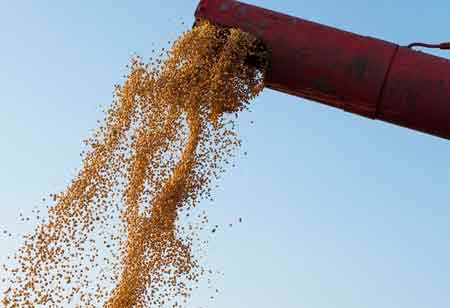Thank you for Subscribing to Agri Business Review Weekly Brief
Driving Innovation in Seed and Grain Cleaning Equipment

By
Agri Business Review | Wednesday, March 26, 2025
Stay ahead of the industry with exclusive feature stories on the top companies, expert insights and the latest news delivered straight to your inbox. Subscribe today.
The seed and grain cleaning equipment industry is essential in modern agriculture, providing crucial solutions to enhance crop production quality and efficiency. As agricultural practices evolve, so do the technologies supporting them, driving continuous innovation within this sector. The demand for efficient, high-quality cleaning machinery has grown as agriculture becomes more technologically advanced.
Technological Advancements Shaping the Future of Seed and Grain Cleaning
Precision and automation are central to these advancements, as stakeholders increasingly seek equipment that enhances productivity, decreases labor costs, and enhances overall operational efficiency. Integrating artificial intelligence (AI) and data analytics into cleaning processes has led to more intelligent, adaptive systems that deliver higher precision in seed and grain sorting. This is particularly valuable in ensuring optimal quality, which remains a critical factor in the industry. The growing focus on product quality and the enhancement of cleaning technology aligns with the broader agricultural industry’s shift toward modernization and efficiency.
Challenges and Innovations in Equipment Design for Diverse Materials
One of the primary challenges companies face in the seed and grain cleaning equipment sector is the increasing complexity of raw material varieties. Different types of seeds and grains have specific cleaning needs, making it difficult for manufacturers to create universal solutions that can handle all materials effectively.
To address this, companies have developed customizable cleaning machines that offer flexibility in their settings. These machines allow for adjustment based on the processed grain or seed’s specific size, shape, and density. This adaptability enhances efficiency, as operators can fine-tune the equipment to meet the particular requirements of various materials, minimizing waste and improving throughput.
One major challenge is the necessity for ongoing innovation to keep pace with market demands. The agricultural sector is evolving, and manufacturers must adopt the latest technological advancements in their equipment. Failure to do so can result in companies falling behind in terms of competitiveness.
To overcome this, leading manufacturers invest heavily in research and development to introduce cutting-edge solutions. Companies optimize cleaning processes by adopting new technologies like machine learning and artificial intelligence. These innovations enable machines to recognize patterns, detect contaminants more accurately, and adjust settings in real time, significantly improving the efficiency and quality of cleaning operations.
Rising energy consumption and high operational costs have challenged companies, particularly those working in volatile energy prices. Energy-efficient cleaning equipment has become a key area of focus, with manufacturers developing machines that consume less power while maintaining high performance.
Innovations such as energy recovery systems and low-power consumption motors help reduce operating costs, making these systems more attractive to stakeholders in the sector. As a result, businesses benefit from reduced operational costs and improved profit margins while contributing to sustainable energy practices.
Embracing Automation and Data Analytics for Operational Excellence
The seed and grain cleaning equipment sector presents numerous opportunities for stakeholders to benefit from technological advancements. One of the most notable opportunities lies in the growing demand for automation. Automated systems have revolutionized seed and grain cleaning by significantly reducing human labor requirements and increasing throughput.
Automated machines equipped with sensors, conveyors, and programmable controls offer higher levels of consistency and precision than manual labor, making them an attractive investment for agricultural businesses. This shift toward automation also reduces the likelihood of human error, which can be pricey in terms of quality and time.
Data analytics advances have unlocked new opportunities for stakeholders to optimize their operations. Using sensors and monitoring systems integrated into cleaning equipment allows real-time data collection on various parameters, including humidity, temperature, and grain quality. By analyzing this data, operators can make informed decisions to improve cleaning processes and adjust machine settings for optimal performance.
For example, predictive maintenance using data analytics helps identify potential issues before they cause machine breakdowns, minimizing downtime and prolonging equipment lifespan. This level of predictive insight is invaluable to stakeholders, as it helps reduce maintenance costs and improve the overall efficiency of operations.
Emerging Opportunities in Sustainable and Multifunctional Agricultural Equipment
With the increasing global focus on sustainability, stakeholders increasingly prioritize equipment that minimizes environmental impact. Companies that invest in green technologies, such as energy-efficient motors, eco-friendly materials, and waste reduction systems, stand to gain from the rising consumer demand for environmentally responsible solutions. By offering machines that reduce energy consumption and waste, manufacturers position themselves as leaders in sustainability.
Developing multifunctional cleaning equipment is also a significant opportunity within the sector. Traditionally, seed and grain cleaning machines were designed for specific types of grains or seeds. However, the demand for versatile equipment that can handle multiple types of grains is growing.
Cleaning different materials using a single machine reduces the need for numerous specialized units, which helps lower capital expenditure for businesses in the agricultural sector. Stakeholders, including farmers, processors, and equipment manufacturers, benefit from these advancements by achieving cost savings and improving operational efficiency.





